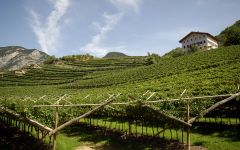Rotari Brut Rose 2015
-
Wine
Enthusiast



Product Details
Your Rating
Somm Note
Winemaker Notes
Beautiful salmon color, with a hint of violet, and copper hues. Aroma of fragrant red fruit with a floral note and aromas of pastry on the nose, and slightly yeasty and brioche character. Rotari Rose is a vibrant expression of fresh, fragrant fruits, with zesty acidity and minerality.
Lovely as an aperitif or paired with appetizers, risotto, or light meat dishes.
Professional Ratings
-
Wine Enthusiast
A blend of Chardonnay and Pinot Nero, this racy sparkler opens with aromas of white spring blossom, mature yellow apple, bread dough and hints of alpine herb. The refreshing, linear palate features juicy red cherry, nectarine and white almond before a zesty orange slice close. Bright acidity and an energized but airy perlage provide the backdrop.
Other Vintages
2016-
Wine
Enthusiast -
James
Suckling -
Wine
Spectator
- Decanter
-
Wine
Enthusiast







Rotari is created in Trentino, in the heart of the Italian Alps: with its peaks and deep valleys, its lakes and forests, its mountain climate and fresh breezes, the region designs the perfect environment for the Chardonnay and Pinot Noir grapes, grown in the steeply terraced vineyards ranging from 950 to 2,500 feet in altitude. Here, the Chardonnay expresses its fresh and fruity character in the best way, while the Pinot Noir succeeds in contributing a particular structure and richness. This is the purest of environments in which the perfect combination of grapes, terrain and variety of microclimates gives life to the elegant and intense bubbles that are the expression of the Trentodoc.
Metodo Classico is the oldest and most prestigious method for producing sparkling wine, based on secondary fermentation in the bottle. The Rotari style is unmistakable; the bubbles are intense and fragrant, elegant and refined, with aromas that are reminiscent of the territory.

What are the different types of sparkling rosé wine?
Rosé sparkling wines like Champagne, Prosecco, Cava, and others make a fun and festive alternative to regular bubbles—but don’t snub these as not as important as their clear counterparts. Rosé Champagnes (i.e., those coming from the Champagne region of France) are made in the same basic way as regular Champagne, from the same grapes and the same region. Most other regions where sparkling wine is produced, and where red grape varieties also grow, also make a rosé version.
How is sparkling rosé wine made?
There are two main methods to make rosé sparkling wine. Typically, either white wine is blended with red wine to make a rosé base wine, or only red grapes are used but spend a short period of time on their skins (maceration) to make rosé colored juice before pressing and fermentation. In either case the base wine goes through a second fermentation (the one that makes the bubbles) through any of the various sparkling wine making methods.
What gives rosé Champagne and sparkling wine their color and bubbles?
The bubbles in sparkling wine are formed when the base wine undergoes a secondary fermentation, which traps carbon dioxide inside the bottle or fermentation vessel. During this stage, the yeast cells can absorb some of the wine’s color but for the most part, the pink hue remains.
How do you serve rosé sparkling wine?
Treat rosé sparkling wine as you would treat any Champagne, Prosecco, Cava, and other sparkling wine of comparable quality. For storing in any long-term sense, these should be kept at cellar temperature, about 55F. For serving, cool to about 40F to 50F. As for drinking, the best glasses have a stem and a flute or tulip shape to allow the bead (bubbles) and beautiful rosé hue to show.
How long do rosé Champagne and sparkling wine last?
Most rosé versions of Prosecco, Champagne, Cava or others around the “$20 and under” price point are intended for early consumption. Those made using the traditional method with extended cellar time before release (e.g., Champagne or Crémant) can typically improve with age. If you are unsure, definitely consult a wine professional for guidance.

A mountainous northern Italian region heavily influenced by German culture, Trentino-Alto Adige is actually made up of two separate but similar regions: Alto Adige and Trentino.
Trentino, the southern half, is primarily Italian-speaking and largely responsible for the production of non-native, international grapes. There is a significant quantity of Chardonnay, Pinot Grigio and Merlot produced. But Trentino's native and most unique red variety, Teroldego, while still rare, is gaining popularity. It produces a deeply colored red wine rich in wild blackberry, herb, coffee and cocoa.
The rugged terrain of German-speaking Alto Adige (also referred to as Südtirol) focuses on small-scale viticulture, with great value placed on local varieties—though international varieties have been widely planted since the 1800s. Sheltered by the Alps from harsh northerly winds, many of the best vineyards are at extreme altitude but on steep slopes to increase sunlight exposure.
Dominant red varieties include the bold, herbaceous Lagrein and delicate, strawberry-kissed, Schiava, in addition to some Pinot Nero.
The primary white grapes are Pinot grigio, Gewürztraminer, Chardonnay and Pinot blanc, as well as smaller plantings of Sauvignon blanc, Müller Thurgau. These tend to be bright and refreshing with crisp acidity and just the right amount of texture. Some of the highest quality Pinot grigio in Italy is made here.
